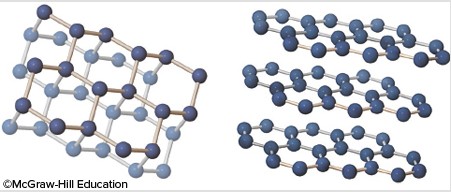How do air masses form? What are their general characteristics?
What will be an ideal response?
An air mass is a volume of air defined by its temperature and vapor content. An air mass is homogeneous mix of temperature, humidity, and stability, which initially reflect the characteristics of its source region.
You might also like to view...
Why is carbon better than lead as a moderator in nuclear reactors?
A. Carbon slows down the neutrons making them more effective in stimulating the nuclear chain reaction. B. Lead slows down the neutrons making them less effective in stimulating the nuclear chain reaction. C. Carbon produces the high energy, high speed neutrons necessary for maintaining the nuclear chain reaction. D. Lead absorbs the neutrons rather than allowing them to rebound to maintain the nuclear chain reaction.
This image shows bonding for graphite (on the left) and diamond (on the right). Both minerals are made of carbon, so why do they have very different properties (why is graphite so soft while diamond is so hard)?
A. Diamond has a different type of covalent bonds between the atoms of carbon than does graphite. B. Minerals with only one type of bond will always be harder than minerals that have two different types of bonding. C. Covalent bonds in both minerals are very strong, but intermolecular bonds between sheets in graphite are very weak. D. Graphite's mixture of covalent and intermolecular bonds is stronger than the solely covalent bonds within diamond.
The latitude of highest mean annual surface temperature, the heat equator, is located about ______ degrees north of the geographical equator.
a. 5 b. 10 c. 15 d. 20
Gyres are the ________ patterns found in major oceans
A) Circular B) East-West C) North-South D) Deep water E) Northbound